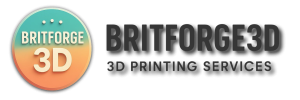
Guides
The Ultimate Beginner’s Guide to 3D Printing
From File to Finished Part
3D printing is no longer just for industrial designers or engineers. Today, it’s a rapidly growing technology embraced by hobbyists, small businesses, educators, and creators across the world especially in the UK. At BritForge3D, our goal is to make 3D printing accessible, reliable, and valuable for everyone.
Whether you’re brand new to the world of additive manufacturing or considering outsourcing your prints to a local UK-based service, this beginner’s guide will equip you with everything you need to know from downloading your first STL file to holding your finished part in your hand.
What Is 3D Printing?
3D printing, also known as additive manufacturing, is a process where physical objects are created layer-by-layer from digital designs. This contrasts traditional subtractive manufacturing (like carving or milling), where material is removed from a block.
With 3D printing, you can create:
- Prototypes and functional parts
- Artistic models and collectibles
- Medical tools and educational aids
- Customised homeware and gadgets
In short, 3D printing turns digital imagination into real, tangible products quickly and affordably.
Common Types of 3D Printing
There are several different 3D printing technologies, each suited for different applications:
1. FDM (Fused Deposition Modelling)
The most common and beginner-friendly method. A spool of filament (like PLA or PETG) is melted and extruded through a heated nozzle to build an object layer by layer.
2. SLA (Stereolithography)
Uses liquid resin cured by a UV laser. SLA prints offer high detail, often used for jewellery, dentistry, and figurines.
3. SLS (Selective Laser Sintering)
Uses powdered material (usually nylon) fused by a laser. It’s ideal for strong, functional prototypes, often used in industrial settings.
At BritForge3D, we primarily use high-quality FDM and resin systems combining detail, strength, and affordability for UK customers.
What Do You Need to Start 3D Printing?
To print at home, here’s what’s typically required:
| Component | Description |
|---|---|
| 3D Printer | Entry-level models like Bambu Lab or Creality are ideal for beginners. |
| Filament or Resin | PLA is beginner-friendly. Other materials include PETG (stronger), TPU (flexible), and ABS (tougher). |
| Slicer Software | Tools like Cura, PrusaSlicer, or Bambu Studio convert models into printer-readable G-code. |
| Digital Model (STL/3MF) | Download from Thingiverse, Printables, or design your own in Fusion 360 or Tinkercad. |
| Post-processing tools | Sandpaper, cutters, and adhesives for finishing your prints. |
Not ready to invest in equipment? BritForge3D allows you to upload your files and get your prints delivered without buying any hardware.
Step-by-Step: How a 3D Print Is Made
Here’s the full process from concept to completion:
- Find or Create a Model
Download from a trusted STL library or design your own using CAD software. - Slice the Model
Open it in a slicer, adjust settings (layer height, supports, infill), and generate G-code. - Send to Printer
Transfer the G-code to your printer via SD card, USB, or Wi-Fi. - Prepare the Printer
Level the bed, preheat the nozzle and bed, load the filament or resin. - Start the Print
Monitor the first layer to ensure adhesion. First layers are critical! - Let It Finish
Print times vary from 30 mins to 12+ hours depending on size and complexity. - Remove & Clean Up
Remove the model carefully. Trim supports, sand surfaces, or glue parts as needed.
Troubleshooting Common Beginner Mistakes
Starting out can feel frustrating if things don’t go perfectly but most issues are easy to fix:
| Problem | Likely Cause | Fix |
|---|---|---|
| First layer not sticking | Bed not levelled | Re-level bed or use a glue stick |
| Warping | Cold bed, no enclosure | Use heated bed and adjust cooling |
| Stringing | High nozzle temp or retraction issues | Tune temperature and retraction settings |
| Layer shifts | Loose belts or fast speeds | Tighten belts, reduce speed |
| Gaps in walls | Low wall thickness or under-extrusion | Increase wall settings and flow rate |
Comparing Filament Materials
| Material | Strength | Flexibility | Print Ease | Use Cases |
|---|---|---|---|---|
| PLA | Medium | Low | ✅ Very easy | Prototypes, models |
| PETG | High | Medium | ✅ Easy | Enclosures, tools |
| TPU | Medium | ✅ High | ⚠️ Moderate | Gaskets, wearable tech |
| ABS | High | Low | ⚠️ Harder | Functional parts, enclosures |
| Nylon | ✅ Very High | ✅ High | ⚠️ Difficult | Gears, industrial parts |
Why Use BritForge3D?
Many customers in the UK don’t want to invest in their own printers and that’s where BritForge3D excels:
- ✅ UK-Based Faster shipping and support
- ✅ Instant Quotes Upload your STL, get a price via email
- ✅ High-Quality Prints We use industrial-grade printers and expert settings
- ✅ Trusted Service Designed for creators, engineers, and educators
Get A QuoteDon’t risk overseas delays, import costs, or poor results support a UK business that delivers every time.
Upload your file now and get a quote
Final Thoughts
3D printing is one of the most empowering technologies available today. It enables anyone to bring ideas into the real world affordably and quickly. Whether you’re just browsing Thingiverse or planning your own product line, the first step is learning what’s possible.
Don’t forget: you don’t have to print it yourself. BritForge3D can handle the slicing, printing, quality checks, and shipping all from our UK workshop.
